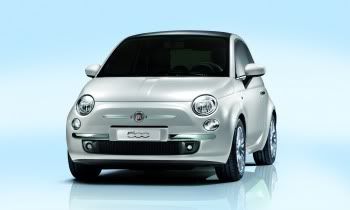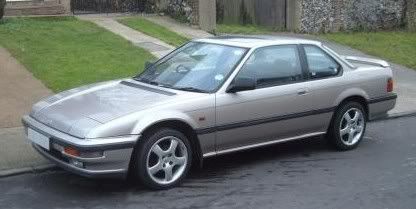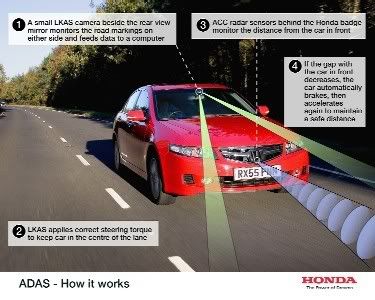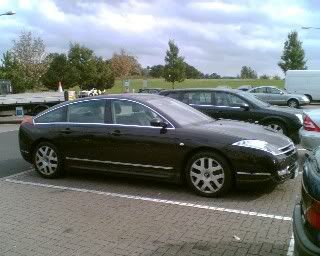Tuesday, 27 March 2007
Success!
Ask any motoring writer and they will take great pains to tell you that their life is not all Ferraris and expensive meals that someone else pays for. Especially when you are trying to start out but even (so I believe) established journalists find it is a life littered with frustrations. If it isn’t editors ignoring your calls then it is a strange absence of vehicles from a manufacturer’s press fleet. But sometimes the celestial bodies align and something you write makes it into print. It happened to me today and I’m so happy I couldn’t resist telling you about it.
Monday, 26 March 2007
Taking it easy
According to the government every motorist should do their best to save fuel. They have even issued advice on how to drive in a fuel-saving manner. Some of the advice is good, sensible stuff; check your tyre pressures, don’t carry un-necessary weight, remove your roofrack if you don’t need it and try to plan ahead to avoid heavy braking. Other stuff is just plain nonsense; you expect governments to tell you to stick to the speed limit whether there is a good reason or not. Even stranger was the advice to change up at no more than 2,500 rpm in petrol cars and 2,000 in diesels. How that advice can be considered right or sensible for all cars escapes me.
In the spirit of enquiry I thought I would try and practice my own economy driving technique. Because my car has automatic transmission and an old-fashioned carburettor with a stiff linkage economy is not its forte. The very worst economy I ever had was 18mpg, when the fuel-air mixture was way out. I have seen this improve to 25 and then 30mpg as I’ve had work done to repair the carburettor. It is telling that the government does not remind us to have our cars tuned up regularly – a telling sign that most cars now have engine management systems that never need tuning.
As for economy driving, my aim is to drive economically with the minimum sacrifice in journey time. One of the most effective techniques, I hope, has been trying not to stop wherever possible – a technique that is good for journey times as well as economy. It requires careful observation, planning, timing and nerves of steel. I always err on the side of caution, however, so the economy benefit might not be what it could be.
The result of my careful driving; so far the fuel economy has increased to 31mpg, which hardly seems a worthwhile return for all the effort. It was disappointing because I had expected more; the needle on the fuel gauge was only just past halfway where I would have expected it to be on the ¼ mark. Whether you agree with saving fuel or reducing CO2 emissions there is no doubting the benefit of easing a few more miles out of a tank and, therefore, making the pound in your pocket go further in every sense.
In the spirit of enquiry I thought I would try and practice my own economy driving technique. Because my car has automatic transmission and an old-fashioned carburettor with a stiff linkage economy is not its forte. The very worst economy I ever had was 18mpg, when the fuel-air mixture was way out. I have seen this improve to 25 and then 30mpg as I’ve had work done to repair the carburettor. It is telling that the government does not remind us to have our cars tuned up regularly – a telling sign that most cars now have engine management systems that never need tuning.
As for economy driving, my aim is to drive economically with the minimum sacrifice in journey time. One of the most effective techniques, I hope, has been trying not to stop wherever possible – a technique that is good for journey times as well as economy. It requires careful observation, planning, timing and nerves of steel. I always err on the side of caution, however, so the economy benefit might not be what it could be.
The result of my careful driving; so far the fuel economy has increased to 31mpg, which hardly seems a worthwhile return for all the effort. It was disappointing because I had expected more; the needle on the fuel gauge was only just past halfway where I would have expected it to be on the ¼ mark. Whether you agree with saving fuel or reducing CO2 emissions there is no doubting the benefit of easing a few more miles out of a tank and, therefore, making the pound in your pocket go further in every sense.
Friday, 23 March 2007
I Must Drive This Car
Fiat has announced a new “500” to go on sale 50 years after the original. The styling draws heavily on the Trepiuno show car of 2 years ago and the 1957 nuvoa 500. Judging by the reaction to Fiat’s preview photos it will be a huge success, there is something about the cute styling and modest size that makes the 500 immediately wantable.

The only worrying thing is whether the driving experience will live up to the styling. The old 500 was loved as much for how it drove as how it looked. The old car could be - had to be - driven flat-out everywhere but seemed to enjoy the treatment. With the engine in the tail the 500 had light, quick steering that no front-wheel-drive car could match. The 500 felt and sounded like nothing else (save its replacement the 126).

The same could not be said of the Cinquecento, the last Fiat to wear the “500” name. In many ways it was a good car, very sensible and practical. It was impressively refined and easy to drive with no quirks. The problem was that it felt just like any other small hatchback, with low-geared steering and a dull engine note.

The latest 500 is a car I can’t wait to get my hands on. The styling both inside and out is so unlike anything else on the market and the 500 shares its “chassis” with the next Ford Ka. The current Ka is great fun to drive as long as the same is true of the new Ka it also promises that the 500 will be great to drive.

The only worrying thing is whether the driving experience will live up to the styling. The old 500 was loved as much for how it drove as how it looked. The old car could be - had to be - driven flat-out everywhere but seemed to enjoy the treatment. With the engine in the tail the 500 had light, quick steering that no front-wheel-drive car could match. The 500 felt and sounded like nothing else (save its replacement the 126).

The same could not be said of the Cinquecento, the last Fiat to wear the “500” name. In many ways it was a good car, very sensible and practical. It was impressively refined and easy to drive with no quirks. The problem was that it felt just like any other small hatchback, with low-geared steering and a dull engine note.

The latest 500 is a car I can’t wait to get my hands on. The styling both inside and out is so unlike anything else on the market and the 500 shares its “chassis” with the next Ford Ka. The current Ka is great fun to drive as long as the same is true of the new Ka it also promises that the 500 will be great to drive.
Saturday, 3 March 2007
In Retrospect – a snapshot of the cars of 2006
To the best of my ability I can remember 10 different cars from 2006. Not all of them were new, half were old cars borrowed from friends or used-car salesmen. The oldest car was 19 years old and the newest “old” cars had seen nine summers. At the start of the year, however, I was driving a car 16 years old. This was my cherished Honda Prelude, a 2.0i 16V 4WS model with leather seats and automatic transmission. It was beautiful to drive, great to travel in and – until the fateful day when it failed – faultlessly reliable. Sadly it did fail and repairing it was not viable so I salvaged the seats, sound system and special alloy wheels. The rest I watched being towed away; it was not a great start to the year.

After an awful, car-less week (frantically searching the used car classified ads) I found a Citroën BX19 (the 19-year old car). It was an unwanted trade-in at a local Ford dealer at a giveaway price and it was basically sound. I always admired Citroën engineering and this was a great opportunity to experience it first hand. The BX even had automatic transmission; I can manage 3 pedals and synchromesh but I prefer a “slushbox” when given the choice. It would be too much to expect something equal to Honda’s superlative engines and transmissions; the Citroën’s engine felt weak and the gear ratios odd but the BX was a relaxing drive. Nor could the BX hope to match the Prelude in the quality of its steering but the ride quality and brakes impressed me from day one. As the year progressed I positively delighted in the brakes; responsive to the slightest touch and with great reserves of stopping power. The suspension with its self-levelling ability to carry heavy loads and height adjustability to aid loading proved its value through the year. For all its apparent complexity the BX is a supremely practical car.

There was another Prelude, the same year and model as the one that started my year, the only difference was the 5-speed manual transmission. I hoped it might substitute for the car I lost but for many minor reasons it simply was not good enough and I sold it on again.
Shortly after buying the second Prelude (actually my 3rd but that story will have to wait) the first new car of the year came my way. It was the high performance ST version of the Ford Focus. None of the previous Foci to come my way impressed me so my hopes were not high for this one. Maybe it was my low expectations but the ST seriously impressed me. The Volvo-derived 5-cylinder turbocharged engine was a delight, the 6-speed manual transmission could be enjoyed or ignored as circumstances dictated and it felt incredibly surefooted. Not only that but the ST could be sweet and refined, it was at home trickling through town or loafing up the motorway as it was charging up a twisting hill. The Focus ST displayed an uncommon touch of class and the memory of my drive will take a long time to fade.

Another car that could speed effortlessly uphill was the Lexus coupé, also known as the Toyota Soarer. Soarer is a good name; it perfectly describes the way this elegant car moves. It is a complicated car, with numerous switches labelled with obscure acronyms or Japanese characters. Setting the radio or air conditioning without being shouted at in Japanese was a tricky business. At least the basic controls were straightforward, with little skill and less effort the Soarer could cover the ground quickly in great comfort and security. No other car in my experience offered such great reserves of overtaking ability. The only problem was giving it back to its rightful owner.
The simplicity of the VW Urban Fox was a stark contrast to the elaboration of the Lexus. It may have had 5 fewer cylinders and roughly 200 less horsepower but the VW was, in its own way, every bit as satisfying as the Lexus. My only objections to the Fox is that it is not a small car; but since it was never intended to be small only cheap my objection is rendered invalid; and the way the windscreen pillars obscured the view, but every new car seems to suffer the same problem. To VW’s credit the Fox does not feel cheap, all the basics are there, it is reasonably lively, tolerably refined and the ride and handling are nicely judged. No car (except perhaps my Citroën BX) impressed me with the breadth of ability available for so little money.
For all the Fox’s sensible qualities I found the 1999 Honda Prelude 2.2 VTi rather more enticing. A friend was thinking of buying the Prelude and as the local expert in all things Prelude I selflessly offered my services to evaluate it. It felt like a dream, the V-tec engine married superbly to the 4-speed automatic transmission, the electronic 4-wheel steering was subtle yet brilliant and the refinement, comfort and smoothness were an unexpected bonus. My friend decided against the Prelude and my only regrets were that I did not have more time with it and that I could not afford to buy it myself.

The Prelude started a short run of Hondas; there was an intriguing Accord 2.4 with lane following steering and distance keeping cruise control. Judged within the terms of what they are supposed to do the systems worked very well. As an aid to the frequent motorway driver they might even be useful. Even now I am unsure whether such driver aids are a desirable use of technology. Aside from that the Accord was perfectly good if unremarkable car, the automatic transmission was better for having 5 ratios and the engine was – if only theoretically – worse for not having 6-cylinders. The most memorable moment in the Accord was the abashed reaction of the man from Honda when a friend of mine claimed the ride “wasn’t bad”. The man from Honda breathed a sigh of relief when it turned out that my friend’s benchmark was his Series 3 Jaguar XJ6.

The other Honda was a Civic 2.2CDTi. I admired the Civic’s styling and interior but I was severely disappointed by Honda opting for Macpherson struts at the front and a torsion beam axle for the rear suspension. Ten years ago Civics rode on double wishbone suspension all round; as the styling has advanced the underpinnings appear to have regressed. At least evidence of progress could be found under the bonnet. Here was a diesel engine that did not feel, sound or perform like a diesel; maybe one day I will find one that I do not find objectionable. It is a shame that the rest of the Civic does not feel as bold and clever as the styling.
It is slightly sad to reflect that the Citroën C6 does not feel quite as bold and clever as a Citroën should. At least by any other standards it seemed pretty astonishing. I was interested in the suspension geometry so, abandoning all mechanical sympathy, I swung the wheels onto full lock while the car was parked. I wanted to see if the camber of the front wheels changed as the front wheels steered. The wheels remained perpendicular to the road and I was pleased; the Citroen CX, which has been identified as the C6’s spiritual predecessor, enjoyed similarly pure geometry. The CX never enjoyed the roll-free cornering that makes the C6 so extraordinary. In high winds and on twisting roads it felt incredibly composed and surefooted. I was disappointed that the brakes did not match those on my BX for response but that is what you get when you swap high-pressure hydraulics for a conventional brake servo. The creeping, dead hand of convention seemed ever present in the C6 and yet the more I think about it the more favourably I view the Citroën. I remember the ride, the poise, the refinement and the superb interior. More than any other new car I drove last year the Citroën felt modern.

The best thing about last year’s cars was the sheer variety offered. Every car demonstrated something of interest, which is what every critic wants; there is nothing worse than the car about which nothing can be said. And it was a relief not to encounter a bad car; if only the same was true every year.

After an awful, car-less week (frantically searching the used car classified ads) I found a Citroën BX19 (the 19-year old car). It was an unwanted trade-in at a local Ford dealer at a giveaway price and it was basically sound. I always admired Citroën engineering and this was a great opportunity to experience it first hand. The BX even had automatic transmission; I can manage 3 pedals and synchromesh but I prefer a “slushbox” when given the choice. It would be too much to expect something equal to Honda’s superlative engines and transmissions; the Citroën’s engine felt weak and the gear ratios odd but the BX was a relaxing drive. Nor could the BX hope to match the Prelude in the quality of its steering but the ride quality and brakes impressed me from day one. As the year progressed I positively delighted in the brakes; responsive to the slightest touch and with great reserves of stopping power. The suspension with its self-levelling ability to carry heavy loads and height adjustability to aid loading proved its value through the year. For all its apparent complexity the BX is a supremely practical car.

There was another Prelude, the same year and model as the one that started my year, the only difference was the 5-speed manual transmission. I hoped it might substitute for the car I lost but for many minor reasons it simply was not good enough and I sold it on again.
Shortly after buying the second Prelude (actually my 3rd but that story will have to wait) the first new car of the year came my way. It was the high performance ST version of the Ford Focus. None of the previous Foci to come my way impressed me so my hopes were not high for this one. Maybe it was my low expectations but the ST seriously impressed me. The Volvo-derived 5-cylinder turbocharged engine was a delight, the 6-speed manual transmission could be enjoyed or ignored as circumstances dictated and it felt incredibly surefooted. Not only that but the ST could be sweet and refined, it was at home trickling through town or loafing up the motorway as it was charging up a twisting hill. The Focus ST displayed an uncommon touch of class and the memory of my drive will take a long time to fade.

Another car that could speed effortlessly uphill was the Lexus coupé, also known as the Toyota Soarer. Soarer is a good name; it perfectly describes the way this elegant car moves. It is a complicated car, with numerous switches labelled with obscure acronyms or Japanese characters. Setting the radio or air conditioning without being shouted at in Japanese was a tricky business. At least the basic controls were straightforward, with little skill and less effort the Soarer could cover the ground quickly in great comfort and security. No other car in my experience offered such great reserves of overtaking ability. The only problem was giving it back to its rightful owner.
The simplicity of the VW Urban Fox was a stark contrast to the elaboration of the Lexus. It may have had 5 fewer cylinders and roughly 200 less horsepower but the VW was, in its own way, every bit as satisfying as the Lexus. My only objections to the Fox is that it is not a small car; but since it was never intended to be small only cheap my objection is rendered invalid; and the way the windscreen pillars obscured the view, but every new car seems to suffer the same problem. To VW’s credit the Fox does not feel cheap, all the basics are there, it is reasonably lively, tolerably refined and the ride and handling are nicely judged. No car (except perhaps my Citroën BX) impressed me with the breadth of ability available for so little money.
For all the Fox’s sensible qualities I found the 1999 Honda Prelude 2.2 VTi rather more enticing. A friend was thinking of buying the Prelude and as the local expert in all things Prelude I selflessly offered my services to evaluate it. It felt like a dream, the V-tec engine married superbly to the 4-speed automatic transmission, the electronic 4-wheel steering was subtle yet brilliant and the refinement, comfort and smoothness were an unexpected bonus. My friend decided against the Prelude and my only regrets were that I did not have more time with it and that I could not afford to buy it myself.

The Prelude started a short run of Hondas; there was an intriguing Accord 2.4 with lane following steering and distance keeping cruise control. Judged within the terms of what they are supposed to do the systems worked very well. As an aid to the frequent motorway driver they might even be useful. Even now I am unsure whether such driver aids are a desirable use of technology. Aside from that the Accord was perfectly good if unremarkable car, the automatic transmission was better for having 5 ratios and the engine was – if only theoretically – worse for not having 6-cylinders. The most memorable moment in the Accord was the abashed reaction of the man from Honda when a friend of mine claimed the ride “wasn’t bad”. The man from Honda breathed a sigh of relief when it turned out that my friend’s benchmark was his Series 3 Jaguar XJ6.

The other Honda was a Civic 2.2CDTi. I admired the Civic’s styling and interior but I was severely disappointed by Honda opting for Macpherson struts at the front and a torsion beam axle for the rear suspension. Ten years ago Civics rode on double wishbone suspension all round; as the styling has advanced the underpinnings appear to have regressed. At least evidence of progress could be found under the bonnet. Here was a diesel engine that did not feel, sound or perform like a diesel; maybe one day I will find one that I do not find objectionable. It is a shame that the rest of the Civic does not feel as bold and clever as the styling.
It is slightly sad to reflect that the Citroën C6 does not feel quite as bold and clever as a Citroën should. At least by any other standards it seemed pretty astonishing. I was interested in the suspension geometry so, abandoning all mechanical sympathy, I swung the wheels onto full lock while the car was parked. I wanted to see if the camber of the front wheels changed as the front wheels steered. The wheels remained perpendicular to the road and I was pleased; the Citroen CX, which has been identified as the C6’s spiritual predecessor, enjoyed similarly pure geometry. The CX never enjoyed the roll-free cornering that makes the C6 so extraordinary. In high winds and on twisting roads it felt incredibly composed and surefooted. I was disappointed that the brakes did not match those on my BX for response but that is what you get when you swap high-pressure hydraulics for a conventional brake servo. The creeping, dead hand of convention seemed ever present in the C6 and yet the more I think about it the more favourably I view the Citroën. I remember the ride, the poise, the refinement and the superb interior. More than any other new car I drove last year the Citroën felt modern.

The best thing about last year’s cars was the sheer variety offered. Every car demonstrated something of interest, which is what every critic wants; there is nothing worse than the car about which nothing can be said. And it was a relief not to encounter a bad car; if only the same was true every year.
Subscribe to:
Posts (Atom)
